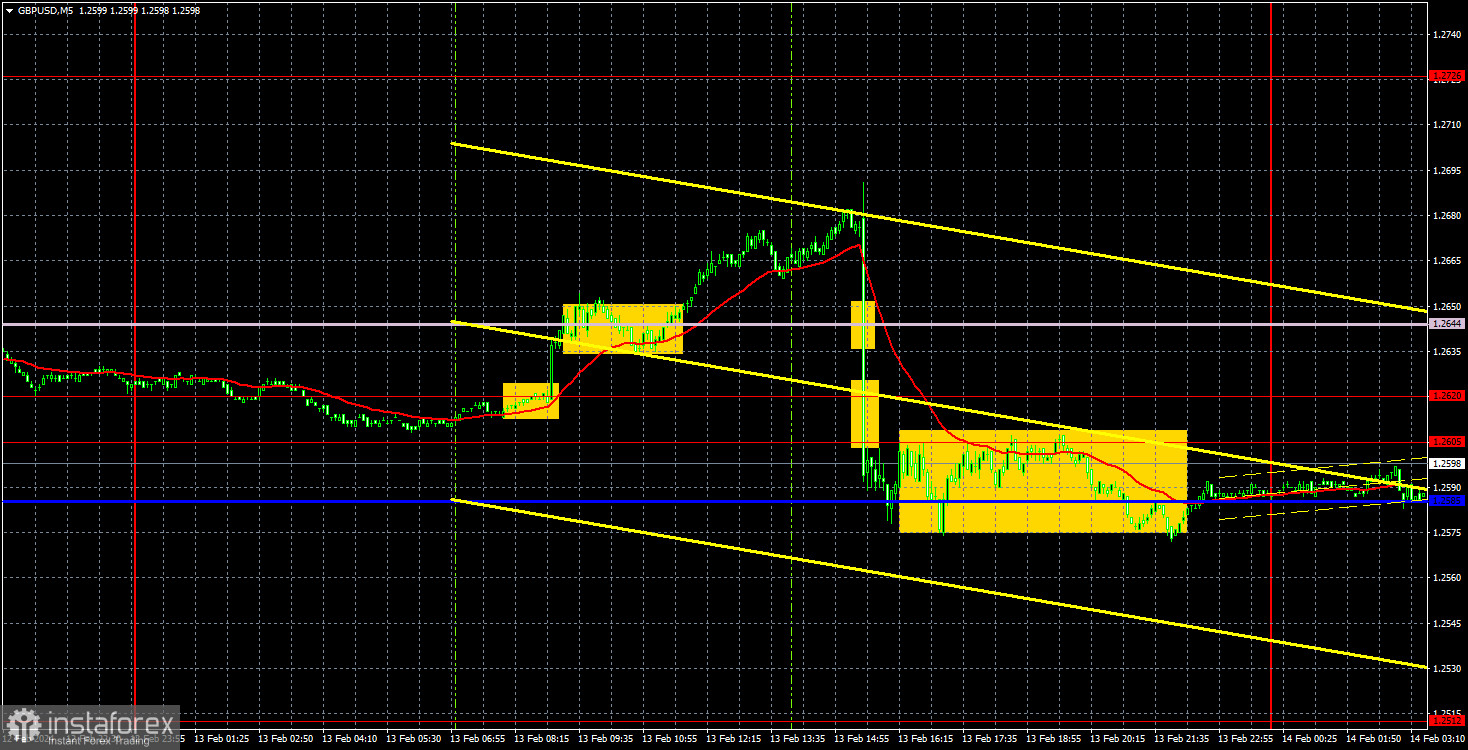Analysis of GBP/USD 5M

GBP/USD sharply traded lower on Tuesday. The sole reason was the US inflation data, which dropped less than expected. The dollar strengthened amid the market's hawkish expectations from the Federal Reserve. If inflation does not slow down significantly, it means the Fed could keep the rate low for an extended period. Initially, the market expected the first rate cut as early as March.
But traders were not only interested in the inflation data. The UK released reports on unemployment, unemployment benefit claims, and average wages. The unemployment rate was lower than forecast, and wage growth slowed less than expected. High wage growth rates are one of the reasons for high inflation in the UK. Therefore, the higher the wage growth, the higher the potential inflation could be. In this case, the Bank of England has even less reason to lower the rate. Therefore, two out of three reports provided support for the British pound, which confidently rose in the first half of the day.
In regards to the technical picture, overall, it has not changed at all. The British currency needs to return to the level of 1.2516 in order for bears to potentially start forming a downward trend. Currently, we are still observing the same flat, but in a different range.
There were quite a few trading signals on Tuesday. During the European session, the pair formed two good buy signals near the 1.2605-1.2620 area and the Senkou Span B line. These signals could have earned about 40 pips in profit, but the trade should have been manually closed before the US inflation data. There was no opportunity to execute all subsequent signals as the pound simply tumbled, staying within the area where two levels and the Kijun-sen line were present. It made no sense to trade between them.
COT report:
COT reports on the British pound showed a bullish bias. According to the latest report on the British pound, the non-commercial group opened 6,400 buy contracts and 6,100 short ones. As a result, the net position of non-commercial traders increased by 300 contracts in a week. The size of the net position implies that the number of long positions had not decreased, so the COT report does not suggest that the pound will start a pronounced decline. The fundamental background still does not provide grounds for long-term purchases of the British currency, but we can't confirm that this supports the downward movement.
The non-commercial group currently has a total of 83,900 buy contracts and 49,500 sell contracts. Since the COT reports do not provide an accurate forecast of the market's behavior at the moment, we need to pay close attention to the technical picture and economic reports. The technical analysis suggests that there's a possibility that the pound could show a pronounced downward movement, and for a long time now, the economic reports have also been significantly stronger in the United States than in the United Kingdom, but this has not benefited the dollar.
Analysis of GBP/USD 1H

On the 1H chart, GBP/USD is no longer trading in the sideways channel and it may be on track to form a downtrend. However, recently, we've noticed that the market is not in a rush to sell the pound. Hopefully, this is a temporary situation, but lately, the price has been moving sideways for a week. This week's macroeconomic background is quite strong, so we can still expect trends. However, the British pound is a currency that tends to move sideways, trading in a somewhat illogical and confusing manner.
As of February 14, we highlight the following important levels: 1.2215, 1.2269, 1.2349, 1.2429-1.2445, 1.2516, 1.2605-1.2620, 1.2726, 1.2786, 1.2863, 1.2981-1.2987. The Senkou Span B (1.2644) and Kijun-sen (1.2630) can also serve as sources of signals. Don't forget to set a breakeven Stop Loss to breakeven if the price has moved in the intended direction by 20 pips. The Ichimoku indicator lines may move during the day, so this should be taken into account when determining trading signals.
On Wednesday, the UK will publish a crucial inflation report. The market could show a strong reaction to this data. It might even be similar to the market's reaction to the US inflation data. If the Consumer Price Index rises for January, this could provide a good amount of support for the pound.
Description of the chart:
Support and resistance levels are thick red lines near which the trend may end. They do not provide trading signals;
The Kijun-sen and Senkou Span B lines are the lines of the Ichimoku indicator, plotted to the 1H timeframe from the 4H one. They provide trading signals;
Extreme levels are thin red lines from which the price bounced earlier. They provide trading signals;
Yellow lines are trend lines, trend channels, and any other technical patterns;
Indicator 1 on the COT charts is the net position size for each category of traders;
Indicator 2 on the COT charts is the net position size for the Non-commercial group.





















